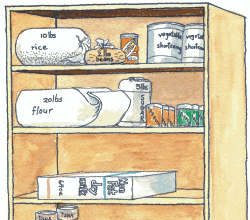 |
|
| Issue #101 • September/October, 2006 |
When I bought 10 dry barren “affordable” acres back in 1981 I got what I paid for: No electricity, no septic system, no well, and no water. What I did get was a long narrow rectangle carpeted with star thistle and poison oak, situated on the southern face of a hill (500’x1320′). Buying bare land was a big gamble, but I wanted my own piece of dirt so badly, I could taste itif only I had some water to wash it down with. Thanks to the local well driller and good ol’ Mother Nature, I got that drink of water. I lucked out and struck it rich with a 50 GPM well at a depth of 150 feet for $3,000.

The next steps were basic. I procured the appropriate permits, built a pump house around the well casing, set a power pole, wired in an electrical box and meter, and called the inspector.
When all my lifelines were hooked up, I installed a submersible pump from Sears by following the do-it-yourself instructions, and to my amazement, when I turned on the control box, water spewed right up out of the pipe! Now I could get serious about improving the property. I’d start with a water storage tank because I believe “you are only as secure as your water supply.”
To take advantage of gravity for water-on-demand, the logical place to put a holding tank was at the top of the hill, with the well at the bottom. I called a backhoe man to dig a 3′ deep trench 1/4-mile long and level a spot at the top end for a 12’x12’x6′ concrete tank (6500-gallon capacity).
The 2hp submerged pump in the well would fill the tank via an 1-1/2″ PVC pipe buried in the trench. When the tank was full, I’d use the same pipe to gravity feed water to supply all my household and irrigation needs. Every 60 feet down the line, I would put a 1″ PVC riser sticking up out of the main pipe and cap it with a non-siphoning valve for irrigation. I would later put in 1″ PVC pipes underground off of that main line as needed to supply my various structures as I built them.
|
With a holding tank I would have the security of a week’s or month’s supply of water at a time (depending on the season) if the electricity went off for any reason. A stored supply would also save the pump motor from having to cycle on and off whenever a faucet was turned on. My storage tank would fill up in about 4 hours, then the pump would rest, and the well would replenish itself. It sounded like a good plan, so I got busy hauling gravel. I would need tons of it!
I found a source for cheap crushed gravel (¾ minus, meaning no rocks bigger than 3/4″), but, again you get what you pay forI had to load it myself. I hauled a yard or two a day in my pickup until I stockpiled enough to build the tank. I had it down to a science: Each load took 300 shovels full. When the tires were flattened “just so,” I knew that that amount of too much was just enough. I’d creep home, front end floating, turn into my driveway, and step on it full throttle to get a run at the hill, fishtailing all the way to the top. (I had no roads yet.) Poor old “Bessie,” my 1971 1/2-ton Ford pickup, has endured cruel and unusual punishment for 20 years, hauling a hundred 1-ton loads of gravel for roads and 780 logs for houses, but she’s still going strong.
It took two weeks of shoveling rock to have enough for the job, but loading and unloading the truck 20 times was just the half of it! Each of those 6,000 shovels full of gravel would have to be lifted againeither thrown on the ground to level the pad, or heaved into a cement mixer with sand and cement and water, then dumped and tamped into forms. I looked forward to the day when the “cruel gruel” would be entombed forever.
|
The floor
I had no electricity on top of the hill, so I borrowed a cement mixer and a gas-powered generator from a neighbor. He was a Bill-of-all-trades who also did everything the hard way to save money. I paid him what I could to help me with the general layout of the tank site, which consisted of setting up batter boards and making sure everything was plumb, level, and square. I covered the large pad where the tank would sit with about 8″ of gravel. Then we built the forms out of 2″x8″ lumber, set the 2″ PVC drain pipe in place, and poured the 8″ thick floor in two grueling days (32 mixers full = 4 cubic yards). We used a garden rake and a shovel to evenly distribute the mix around and work it into every corner. Together we dragged a 2”x6” on edge across the surface of the wet concrete floor using the tops of the forms as guidesa procedure called “screeding.” Bill advised me to use no rebar in the slab because it would be filled with water inside and sitting on wet ground outside, and the rebar would eventually rust, leaving voids that would weaken the concrete. Right or wrong, I had no experience to question him, so that’s how we did it.
Before the floor set up as hard as a rock, we roughed up the sides of the slab and a 2″ wide strip around the top perimeter to serve as a keyway (an overhanging lip) to help tie the vertical walls to the floor. We used 5/8″ plywood nailed to 2″x4″ frames for the 8″ thick walls. I sprayed the sheets of plywood with petroleum oil (using a garden sprayer) so they wouldn’t stick to the concrete when it was time for removing and repositioning them.

We secured vertical rebar at 2′ intervals inside the wall cavities. Bill helped me with the floor, but then he had to go to another job, so I carried on solo. A cubic yard and a half of concrete was all I was physically capable of shoveling, pouring, distributing, and tamping in 12 hours. I let each daily pour set up, then moved the forms up and raised the cement mixer platform and piles of ingredients to the new level. Bill stopped by on his way home from work each day to help me lift the heavy stuff.
A series of separate pours meant “cold joints”the lines of demarcation between pours. If the preceding surface is roughed up while the concrete is still “green,” the next layer bonds just fine. It’s not as ideal as a monolithic pour, but it was the only doable method for me.
The recipe
There are three basic mixtures that are commonly used for concrete construction, from strongest to strong enough. They differ in the ratio of the three basic ingredients: Cement, sand, and stone. How they are proportioned makes a huge difference in strength and durability. The more cement used, the stronger (richer) the mix, with 1:2:4 being a happy medium for most projects. The less water you can use in relation to the dry ingredients and still maintain a workable consistency, the stronger the mix. A runny mix is weak.
|
The consistency of fresh mixed concrete should feel like oatmeal cookie batterbut don’t lick your fingers. The trick is to not touch the mix at all with bare hands, but for a novice, that’s easier said than done because it’s tempting to catch the drips and smear them around.
Because Portland cement has abrasive silica and caustic lime in it, I ended up with no fingerprints at all until the “tread” grew back. It would have been a good time to take up a life of crime, but I stayed on the straight and narrowand plumb.
When you make a batch of concrete, the sum total of the ingredients mixed together will result in a much smaller volume than the separate componentskind of like what happens to that mountain of flour when you make a loaf of bread, or when you can’t believe you just used a 1/2-gallon of ice cream to make only two decent-sized milkshakes.
Bill advised me to use a 1:3:5 mix: 1 heaping shovel of cement to 3 of sand, and 5 of gravel. For me, that mixture would be economical for my budget and yet strong enough for my particular application: a heavy foundation and thick retaining walls. Because the tank would be sitting on impenetrable hard rock, I knew it would have to be back-filled to bury it partially underground, which would also help equalize the pressure on the walls. (Water weight pushes out; wall of dirt pushes in.) Backfilling would also keep the water cool in the summer.
Calculating what you need
Using some simple math, I estimated the walls would take 8 cubic yards. Here’s how: Multiply length (12′) x height (6′) x thickness (¾ of a foot = .75) x 4 walls and divide by 27 because there are 27 cubic feet in one cubic yard.
The walls
The growling gyrating cement mixer held 1/8 cubic yard (approximately 3.5 cubic feet) at a time, gobbling up 2 shovels of cement, 6 shovels of sand, 10 shovels of gravel. I worked as fast as I could slinging them in, counting and alternating the ingredients very carefully, while constantly adding the water with a measuring bucket (about 4 gallons).
|
When the batter was “just right,” I shut off the motor, swung the cement mixer around on its axis and dumped the load into the forms, then tamped, tamped, and tamped with the business end of a short shovel. I also tapped the sides of the forms with a hammer to vibrate the concrete into every nook and cranny. On the fifth and final pour, I set a pipe through the wall near the top to make an overflow hole. I would later run a 1-1/2″ poly-pipe through that hole and out to my pond.
Each daily pour amounted to 12 mixers full, which totaled 24 shovels of cement, 72 shovels of sand, 120 shovels of gravel, and 48 gallons of water. I guzzled another 10 gallons of water and dumped even more on my head. It took five days of working from daybreak to backbreak to complete the walls. The whole project had to be a marathon because concrete sets up fast in extreme heat, and time was running out on my week vacation from waitressing.
Needless to say, I put my fitness center membership on hold for a while. Sixteen Tons by Tennessee Ernie Ford was my theme song for the week, although the tank ended up weighing 24 tons. Blistered hands on Monday had turned into lobster claws by Friday.
The roof
|
On top of the last pour, I dragged a short 2”x6” on edge across the 8″ wide wet surfaces to smooth them out. I then set four 2″x4″ pressure-treated sill plates in the concrete and leveled them with a long level by tamping and wiggling them into place around the outside perimeter, making sure the corners were squared.
They would be an integral part of the roof construction, providing a wood surface to build a short stem wall on. The “pony wall” would be screened for cross-ventilation, rather than covered with plywood. I built a gabled roof on the tank, with the rafter tails secured to the top plate of the stem wall. (See photos)
When the job was done (floor AND walls), I had used approximately 55 sacks of Portland cement, 6 cubic yards of sand, 10 cubic yards of gravel, and about 400 gallons of water. Not exactly like building Hoover Dam, but it felt like it.
I kept the concrete slab and walls wet while they were curing by spraying everything down with a hose, including myself, as often as possible. I had a hose hooked up to the inlet/outlet pipe in the floor of the tank so water was handy.
Note: This mandatory procedure should go on for at least a week when working in hot weather.
Sealing the tank
I think the reason my tank has held up so well for 23 years now, in spite of the 1:3:5 “poorman’s mix” I used, is because I coated the inside of the tank with a cohesive sealer called “Thoroseal.”
|
Thoroseal is a Portland-cement-based coating that, when mixed with a milky-looking catalyst called Acryl 60, fills and seals voids and waterproofs the concrete. It prevents any water seepage from leaking into fissures where it might freeze and expand and crack the concrete. It also resists hydrostatic pressure (as inside a water tank) and is non-toxic in potable water tanks. It can be brushed on, but Bill advised me to trowel it on about 1/4″ thick for an impenetrable bond. It took a lot of elbow grease applying it in smooth swipes on the entire inside surface of the tank, but it covered up all those rough cold-joint seams and made it look as smooth and beautiful as a baby-elephant’s butt.
I don’t claim to be an expert on the subject of concrete tank building. We built the tank during possibly the hottest July in history, so my memory of the details may be a little off due to sunstroke. All I know is that I built it under Bill’s tutelage, and it has stood the test of time.
When I look up the hill and see the water-level flag sticking up out of the tank’s roof and dancing in the breeze, it helps to quench my thirst for security and self-sufficiency.
Back in the summer of 1983, the finished tank with its shingled roof cost me a total of $750 to build, including the lumber and plywood used for the forms.
Today’s average prices
Ingredients to make the concrete:
- 80 lb. bag of Portland cement = $2.50
- Cubic yard of “construction sand” = $15
- Cubic yard of crushed gravel (¾ minus or pea gravel) = $10.
- Note: You can buy construction-grade sand and gravel already mixed in the ratio you want at any large rental equipment yard or your local sand and gravel supplier for about $32/yd. or $350 for a 10-yard dump truck full, delivered to your site. That sure beats the way I did it. Having the raw ingredients delivered would have been heaven instead of “the other place!”
Framing and roofing lumber:
- 2x8s = .70/ft.
- 2x6s = .50/ft.
- 2x4s = .35/ft.
- 5/8″ CDX plywood for roof = $18/sheet
- Roof: I recommend composition roofing (cheap) or metal roofing (fireproof). I used cedar shingles back then, but now I would choose metal roofing and also divert the annual rainfall via rain gutters into the tank to supplement the supply.
Total materials it takes for a 6500-gallon tank:
|
- 55 bags cement = $140
- 5 yds. sand = $75
- 10 yds. gravel = $100
- 2 yds. gravel under pad = $20
- Forms: (40) 2×4 x12s = $168
- (8) 2x8x12s = $67
- (12) sheets of 5/8″ plywood = $216
- Stem-wall: (12) 2x4x12s = $50
- Roof: (20) 2x6x8s = $112
- (12) sheets of 5/8″ plywood = $0 ( I recycled the same plywood I used for the forms)
- Assorted screws and nails and drain hardware: About $50
- Thoroseal: (10) 50-lb. bags to cover 500 sq. ft.= $250
- Acryl 60: 5 gallons = $125
- Composition roofing to cover the 200-sq. ft. roof = about $50
- Labor cost = your energy (a renewable resource)
- Strong back = fringe benefit
- Optional cost of labor if you treat yourself to pizza and beer to celebrate when the job is done = $20
|
The same tank today adds up to $1,500; still not bad for a permanent 6500-gallon water tank. I say “permanent,” but now I have my doubts after overhearing an old timer at the hardware story drawling to another old timer: “There are two kinds of concreteconcrete that’s cracked, and concrete that’s gonna crack.” Then they cackled and wheezed.
Closing thoughts
Any able-bodied person can mix and pour concrete. Building the forms to contain and shape it is the easiest and most elementary carpentry going. So, even though my cave-woman ordeal with concrete might sound difficult, don’t be intimidated by the “stuff.” It’s malleable and infallible. My style is to overbuild everything; it needn’t be yours. If you have a little extra cash and aren’t in a big hurry, working creatively with small batches of concrete mixed in a wheelbarrow can be downright fun!
Editor’s Note: You might be interested in a companion article that Dorothy wrote for our November/December 2004 Issue #90. Entitled, “Water pumping windmills,” Dorothy includes an historical background of windmills, explains how they work, their uses, windmill installation and maintenance, and more. Issue #90 is sold out, but you can view the article online. Photocopies of the 8-page article are available from BHM for $4.
Learn more about Dorothy and/or contact her at her website www.dorothyainsworth.com
























They now make fibermesh reinforcing for concrete. Bigger fibers for stronger applications. Just google it to find various sources. You mix it into the concrete as you go. When everything sets, the fibers interlace like a sort of webbing to make the mix stronger and crack-resistant. This would be a good way to reinforce the mix without the re-bar.
You could actually use rebar, but you would want the coated type (more expensive) and you want to make sure the slab is thick enough to prevent the moisture from getting to the rebar. Too thin and it rusts and explodes (simple version of events but you get the idea). Coatings help as your article mentions. More options there these days as well.
Nice project!
As a kid my dad made round water troughs on the farm from concrete. The molds where made from curved galvanized roof sheets. With 2 bolted together on each side. Very cheap
You have shared wonderful information with us. I would to share with friends and family. Keep it up with good work and keep sharing.
Great read Dorothy Ainsworth. I’m researching how to make a water storage tank for fire suppression. We already have a 2500 gallon plastic tank that I feel is not enough. My concern is it might melt in a wild land fire event. That’s why I like the idea of concrete. I agree about the metal roof and may use galvanized pipe for trusses. Thanks, Don